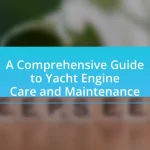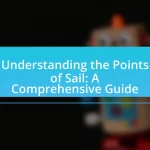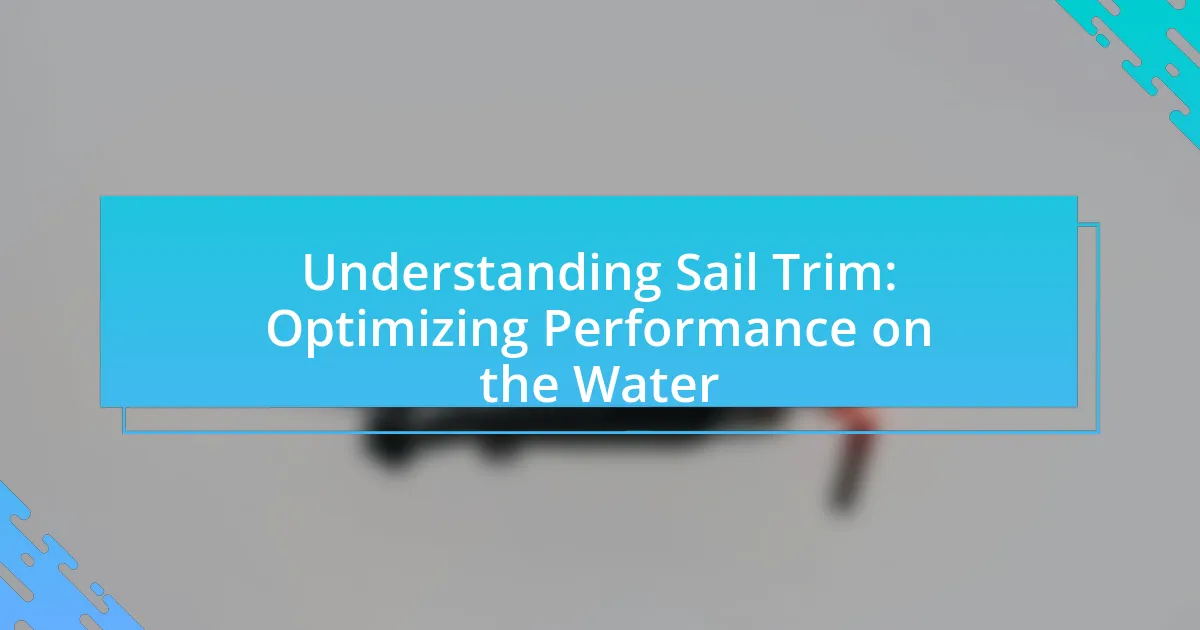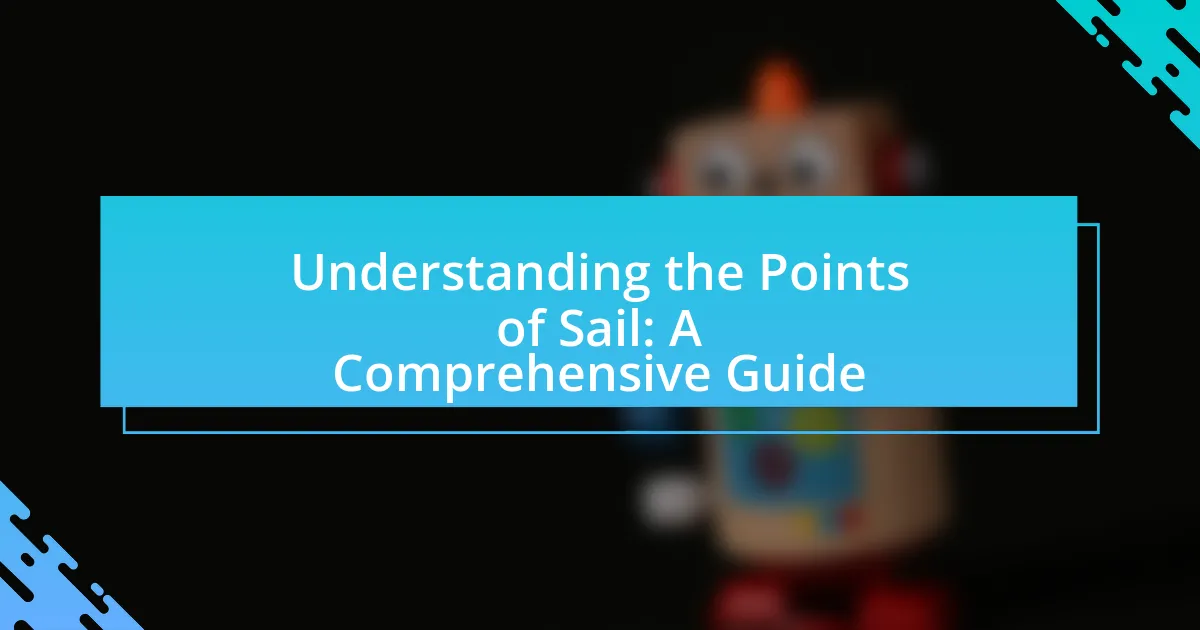The article focuses on essential weather patterns that yacht owners must understand to ensure safe and effective sailing. It covers key topics such as wind patterns, storm systems, temperature fluctuations, and their impact on sailing conditions. The article emphasizes the importance of recognizing high-pressure and low-pressure systems, seasonal weather variations, and the risks associated with tropical storms and hurricanes. Additionally, it provides practical advice on preparing for changing weather conditions, utilizing weather monitoring tools, and implementing safety measures during adverse weather. Understanding these elements is crucial for yacht owners to optimize their sailing experiences and enhance safety on the water.

What are the key weather patterns that yacht owners should be aware of?
Yacht owners should be aware of several key weather patterns, including wind patterns, storm systems, and temperature fluctuations. Wind patterns, such as trade winds and local sea breezes, significantly affect sailing conditions and navigation. Storm systems, including tropical storms and hurricanes, can pose serious risks, with the Atlantic hurricane season typically running from June to November, during which yacht owners should exercise heightened caution. Temperature fluctuations can impact water conditions and visibility, influencing both safety and comfort on the water. Understanding these patterns is crucial for effective planning and risk management in yachting activities.
How do different weather patterns affect sailing conditions?
Different weather patterns significantly impact sailing conditions by influencing wind speed, wave height, and visibility. For instance, strong winds associated with storms can create hazardous sailing conditions, leading to increased wave heights and challenging navigation. Conversely, light winds typical of high-pressure systems may result in calm seas but can hinder sailing progress due to insufficient wind for propulsion. Additionally, weather patterns like fog or heavy rain can reduce visibility, complicating safe navigation. Historical data shows that sailors often adjust their routes and schedules based on these weather patterns to ensure safety and efficiency while at sea.
What are the characteristics of high-pressure systems?
High-pressure systems are characterized by descending air, which leads to clear skies and stable weather conditions. These systems typically feature higher atmospheric pressure at their center compared to the surrounding areas, resulting in outward airflow. The descending air inhibits cloud formation, contributing to dry conditions. Additionally, high-pressure systems often bring light winds and can influence temperature by allowing for more sunlight to reach the surface. These characteristics are essential for understanding weather patterns, particularly for yacht owners who need to anticipate favorable sailing conditions.
How do low-pressure systems influence wind and waves?
Low-pressure systems significantly influence wind and waves by creating conditions that lead to increased wind speeds and larger wave heights. These systems are characterized by lower atmospheric pressure compared to surrounding areas, which causes air to flow toward the low-pressure center. As air converges, it rises, leading to the development of stronger winds. For instance, during a typical low-pressure system, wind speeds can increase by 10 to 20 knots, resulting in waves that can reach heights of 6 to 12 feet or more, depending on the system’s intensity and duration. This relationship between low pressure, wind, and wave formation is critical for yacht owners to understand, as it directly affects sailing conditions and safety at sea.
What role do seasonal weather patterns play in yachting?
Seasonal weather patterns significantly influence yachting by determining sailing conditions, safety, and route planning. For instance, summer typically brings stable winds and warmer temperatures, making it ideal for recreational sailing, while winter may introduce harsher conditions, including storms and colder temperatures, which can pose risks to sailors. Additionally, specific regions experience distinct seasonal patterns; for example, the Caribbean has a hurricane season from June to November, which necessitates careful planning and preparation for yacht owners to avoid dangerous weather. Understanding these patterns allows yacht owners to optimize their sailing experiences and ensure safety on the water.
How do summer weather patterns differ from winter patterns?
Summer weather patterns are characterized by warmer temperatures, increased humidity, and often more intense precipitation compared to winter patterns, which feature colder temperatures, lower humidity, and generally drier conditions. During summer, the sun’s higher angle leads to longer daylight hours and more solar energy, resulting in heat waves and thunderstorms, particularly in tropical and temperate regions. In contrast, winter brings shorter days, reduced solar energy, and can lead to snow and ice formation in colder climates. Historical data shows that summer months can experience average temperatures 10 to 20 degrees Fahrenheit higher than winter months, significantly impacting sailing conditions and yacht operations.
What should yacht owners know about tropical storms and hurricanes?
Yacht owners should know that tropical storms and hurricanes can cause severe damage to vessels and marinas, necessitating proactive measures for safety. Owners must monitor weather forecasts and understand the storm categories, as hurricanes can produce winds exceeding 157 mph and storm surges that can inundate coastal areas. Historical data shows that hurricanes have led to significant losses in the maritime industry; for instance, Hurricane Katrina in 2005 resulted in over $100 billion in damages, highlighting the importance of preparedness. Owners should secure their yachts by using proper mooring techniques, removing loose items, and considering evacuation plans well in advance of a storm’s arrival.
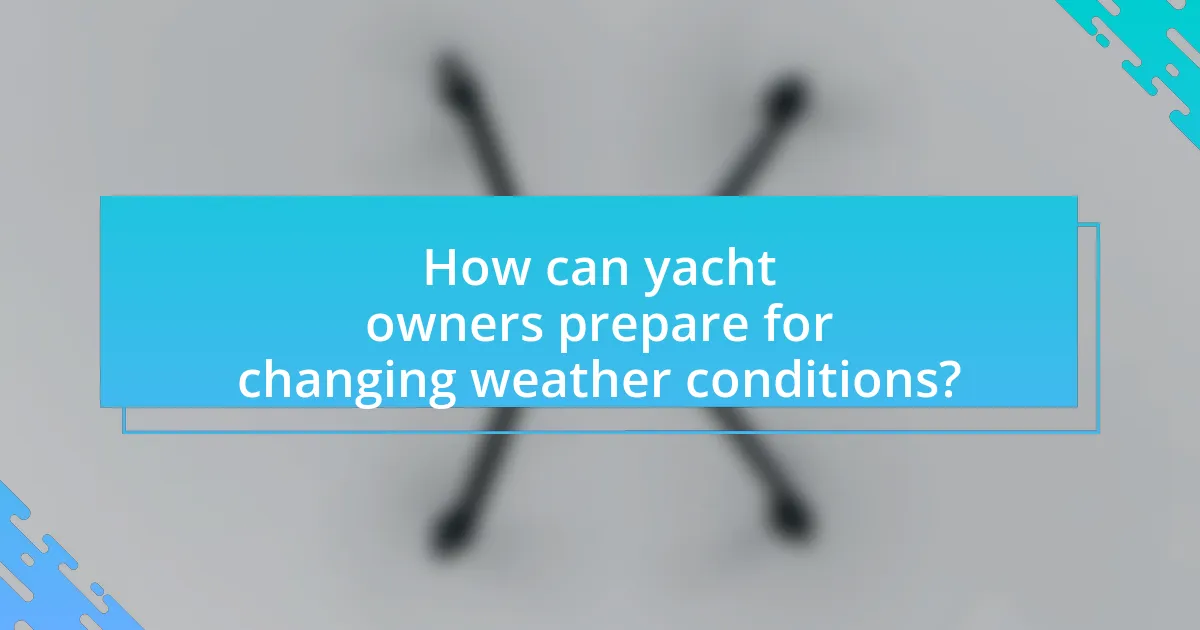
How can yacht owners prepare for changing weather conditions?
Yacht owners can prepare for changing weather conditions by regularly monitoring weather forecasts and utilizing advanced navigation tools. By staying informed through reliable sources such as the National Weather Service or specialized marine weather apps, yacht owners can anticipate shifts in weather patterns. Additionally, equipping the yacht with technology like radar and satellite communication enhances the ability to receive real-time updates, allowing for timely adjustments to sailing plans. Historical data indicates that proactive weather monitoring can significantly reduce risks associated with sudden weather changes, as evidenced by studies showing that informed sailors are less likely to encounter dangerous conditions.
What tools and resources are available for monitoring weather?
Various tools and resources are available for monitoring weather, including weather apps, websites, radar systems, and satellite imagery. Popular weather apps like The Weather Channel and AccuWeather provide real-time updates and forecasts, while websites such as NOAA and Weather.gov offer detailed meteorological data and alerts. Radar systems, including Doppler radar, allow for tracking precipitation and storm systems, and satellite imagery provides a broader view of weather patterns globally. These resources are essential for yacht owners to make informed decisions regarding sailing conditions and safety.
How can weather apps enhance sailing safety?
Weather apps enhance sailing safety by providing real-time weather updates, forecasts, and alerts that help sailors make informed decisions. These applications utilize data from meteorological sources to deliver accurate information on wind speed, wave height, precipitation, and storm warnings. For instance, a study by the National Oceanic and Atmospheric Administration (NOAA) indicates that timely weather alerts can reduce the risk of maritime accidents by allowing sailors to avoid hazardous conditions. By integrating GPS technology, weather apps can also offer localized forecasts, ensuring that sailors receive relevant information specific to their sailing area.
What are the benefits of using marine weather forecasts?
Marine weather forecasts provide critical information that enhances safety and decision-making for maritime activities. These forecasts help yacht owners anticipate weather conditions such as wind speed, wave height, and storm systems, which are essential for planning safe voyages. Accurate marine forecasts can reduce the risk of accidents and improve navigation by allowing sailors to avoid hazardous conditions. For instance, the National Oceanic and Atmospheric Administration (NOAA) reports that timely weather updates can significantly decrease the likelihood of maritime incidents, emphasizing the importance of reliable forecasts in ensuring safe boating experiences.
What safety measures should be taken in adverse weather?
In adverse weather, yacht owners should prioritize safety measures such as securing the vessel, monitoring weather updates, and ensuring all safety equipment is functional. Securing the vessel involves double-checking lines, fenders, and hatches to prevent water ingress and damage. Monitoring weather updates through reliable sources, such as the National Weather Service, allows for timely decisions regarding navigation and anchoring. Ensuring that safety equipment, including life jackets, flares, and fire extinguishers, is in good condition and easily accessible is crucial for emergency preparedness. These measures are essential for minimizing risks associated with adverse weather conditions at sea.
How can yacht owners secure their vessels during storms?
Yacht owners can secure their vessels during storms by ensuring proper mooring techniques and utilizing storm sails. Proper mooring involves using multiple lines to secure the yacht to a dock or mooring buoy, which helps prevent movement caused by strong winds and waves. Additionally, deploying storm sails reduces the sail area, minimizing the risk of damage from high winds. According to the American Boat and Yacht Council, using fenders and adjusting the boat’s position can further enhance stability and protection during severe weather conditions.
What emergency protocols should be established on board?
Emergency protocols that should be established on board include clear communication procedures, designated roles for crew members, and specific actions for various emergency scenarios such as man overboard, fire, flooding, and severe weather. These protocols ensure that all crew members know their responsibilities and can act swiftly in emergencies, minimizing risks and enhancing safety. For instance, the International Maritime Organization emphasizes the importance of drills and training to prepare crew for emergencies, which is supported by safety statistics showing that well-prepared crews can significantly reduce incident severity.

What are the common weather-related challenges faced by yacht owners?
Yacht owners commonly face challenges such as storms, high winds, and unpredictable weather patterns. Storms can lead to dangerous sailing conditions, while high winds can cause capsizing or damage to the yacht. Unpredictable weather patterns, including sudden changes in temperature and precipitation, complicate navigation and planning. According to the National Oceanic and Atmospheric Administration (NOAA), approximately 10% of all boating accidents are attributed to weather-related factors, highlighting the importance of understanding these challenges for safe yacht ownership.
How do wind patterns impact sailing performance?
Wind patterns significantly impact sailing performance by influencing the speed and direction of a sailboat. Consistent wind patterns allow sailors to optimize their course and sail trim, enhancing speed and efficiency. For instance, prevailing winds, such as trade winds, provide reliable conditions for long-distance sailing, while variable winds can lead to unpredictable performance and require constant adjustments. Studies show that understanding local wind patterns, such as sea breezes and land breezes, can improve a sailor’s ability to navigate effectively, as these patterns can create areas of stronger wind that enhance sailing speed.
What are the effects of gusty winds on yacht stability?
Gusty winds significantly affect yacht stability by causing sudden shifts in wind pressure on the sails and hull. These rapid changes can lead to increased heeling, which is the tilting of the yacht to one side, and may result in loss of control if the heeling exceeds safe limits. Research indicates that yachts can experience a 30% increase in heeling moment with gusts exceeding 20 knots, which can destabilize the vessel and increase the risk of capsizing. Additionally, gusty winds can create unpredictable wave patterns, further complicating stability and maneuverability.
How can yacht owners adjust their sails for varying wind conditions?
Yacht owners can adjust their sails for varying wind conditions by changing the angle of the sails relative to the wind direction, known as sail trim. For light winds, sails should be let out to catch as much wind as possible, while in strong winds, sails should be trimmed in to reduce the surface area exposed to the wind, preventing overpowering. Additionally, adjusting the sail shape by using the outhaul, halyard, and backstay can optimize performance based on wind strength. This method is supported by sailing principles that emphasize the importance of sail shape and angle for effective wind utilization.
What are the implications of fog and visibility issues?
Fog and visibility issues significantly impact navigation safety and operational efficiency for yacht owners. Reduced visibility can lead to increased risks of collisions, grounding, and accidents, as vessels may not be able to see other boats, navigational aids, or hazards in the water. According to the U.S. Coast Guard, approximately 30% of all marine accidents occur in conditions of reduced visibility, highlighting the critical need for caution and preparedness. Yacht owners must employ radar, GPS, and sound signals to enhance safety during foggy conditions, ensuring they can navigate effectively despite the challenges posed by limited visibility.
How can yacht owners navigate safely in low visibility conditions?
Yacht owners can navigate safely in low visibility conditions by utilizing radar systems, GPS technology, and sound signals. Radar systems allow yacht owners to detect nearby vessels and obstacles, even when visibility is poor, while GPS provides precise location tracking to ensure safe navigation routes. Additionally, using sound signals, such as fog horns, helps communicate the yacht’s presence to other vessels, reducing the risk of collisions. According to the U.S. Coast Guard, over 70% of marine accidents occur in low visibility, highlighting the importance of these navigational aids for safety.
What equipment can assist in foggy conditions?
Radar systems can assist in foggy conditions by providing real-time information about nearby vessels and land obstacles. These systems use radio waves to detect objects, allowing yacht operators to navigate safely even when visibility is severely reduced. According to the U.S. Coast Guard, radar is essential for safe navigation in low visibility situations, as it can identify objects up to several miles away, depending on the radar’s specifications. Additionally, fog horns and navigation lights enhance safety by alerting other vessels to a yacht’s presence, further reducing the risk of collisions in foggy weather.
What practical tips can yacht owners follow to navigate weather patterns effectively?
Yacht owners can navigate weather patterns effectively by utilizing reliable weather forecasting tools and staying informed about local conditions. Regularly checking marine weather services, such as NOAA or local coast guard reports, provides accurate and timely information on wind speeds, wave heights, and storm warnings. Additionally, yacht owners should invest in onboard weather radar and satellite communication systems to monitor real-time changes while at sea. Historical data on weather patterns in specific regions can also guide decision-making, as understanding seasonal trends helps in planning safe voyages.
How can regular weather updates improve sailing decisions?
Regular weather updates significantly enhance sailing decisions by providing real-time information on wind patterns, storm developments, and sea conditions. This timely data allows sailors to adjust their routes, avoid hazardous weather, and optimize sailing performance. For instance, a study by the National Oceanic and Atmospheric Administration (NOAA) indicates that sailors who utilize updated weather forecasts can reduce the risk of encountering severe weather by up to 30%. By staying informed, sailors can make proactive choices that ensure safety and efficiency on the water.
What are the best practices for planning a sailing trip around weather forecasts?
The best practices for planning a sailing trip around weather forecasts include regularly checking reliable weather sources, understanding local weather patterns, and having contingency plans. Regularly checking sources such as the National Weather Service or specialized marine weather services provides up-to-date information on conditions like wind speed, wave height, and storm warnings. Understanding local weather patterns, such as seasonal changes and typical wind directions, helps sailors anticipate conditions they may encounter. Additionally, having contingency plans, such as alternative routes or safe harbor options, ensures preparedness for sudden weather changes, which is crucial given that approximately 70% of sailing accidents are weather-related.











